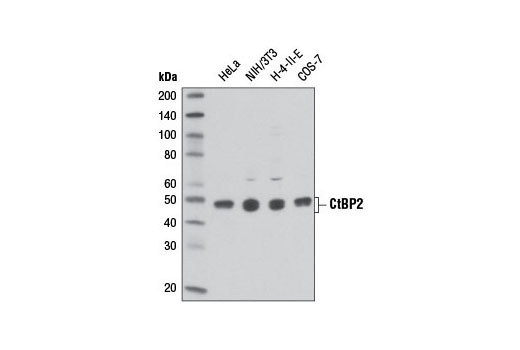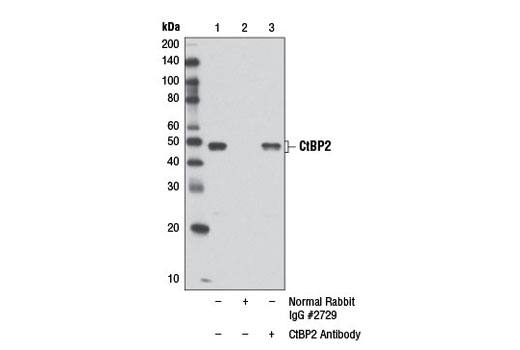WB, IP
H M R Mk
Endogenous
47
Rabbit
#P56545
1488
Product Information
Product Usage Information
| Application | Dilution |
|---|---|
| Western Blotting | 1:1000 |
| Immunoprecipitation | 1:50 |
Storage
Specificity / Sensitivity
Species Reactivity:
Human, Mouse, Rat, Monkey
Species predicted to react based on 100% sequence homology
The antigen sequence used to produce this antibody shares
100% sequence homology with the species listed here, but
reactivity has not been tested or confirmed to work by CST.
Use of this product with these species is not covered under
our
Product Performance Guarantee.
Bovine, Dog, Guinea Pig
Source / Purification
Polyclonal antibodies are produced by immunizing animals with a synthetic peptide corresponding to residues near the carboxy terminus of human CtBP2 protein. Antibodies are purified by protein A and peptide affinity chromatography.
Background
CtBP2 (carboxy-terminal binding protein-2) and its homolog CtBP1 are transcriptional co-repressors originally identified as proteins that bind the carboxy-terminus of the human adenovirus E1A protein (1-3). CtBP proteins are thought to play important roles in regulating various developmental pathways because deletion of CtBP2 leads to embryonic lethality at E10.5 and is correlated with axial patterning defects (4). CtBP proteins regulate various oncogenic signaling pathways as promoters of epithelial-mesenchymal transition, apoptosis antagonists, and tumor suppressor genes repressors (1,5). The CtBP protein transcription co-repression activity results from interactions with numerous transcription factors and chromatin modulators, including the polycomb group proteins (1,6,7). Depending on the context, CtBP proteins interact with a short amino acid sequence motif (PXDLS) to mediate repression of target genes through both histone deacetylase-dependent and independent mechanisms (6,8,9). CtBP proteins display a high sequence homology to the bacterial D-isomer-specific 2-hydroxyacid dehydrogenase enzymes. Research studies indicate that nuclear NADH levels regulate CtBP transcription repression activities, as NADH binding is required for CtBP2 homodimerization and transcription co-repressor activity (6,9-11).
- Chinnadurai, G. (2009) Cancer Res 69, 731-4.
- Boyd, J.M. et al. (1993) EMBO J 12, 469-78.
- Katsanis, N. and Fisher, E.M. (1998) Genomics 47, 294-9.
- Hildebrand, J.D. and Soriano, P. (2002) Mol Cell Biol 22, 5296-307.
- Battaglia, S. et al. (2010) Int J Cancer 126, 2511-9.
- Chinnadurai, G. (2002) Mol Cell 9, 213-24.
- Sewalt, R.G. et al. (1999) Mol Cell Biol 19, 777-87.
- Molloy, D.P. et al. (1998) J Biol Chem 273, 20867-76.
- Schaeper, U. et al. (1995) Proc Natl Acad Sci U S A 92, 10467-71.
- Kumar, V. et al. (2002) Mol Cell 10, 857-69.
- Thio, S.S. et al. (2004) Nucleic Acids Res 32, 1836-47.
Species Reactivity
Species reactivity is determined by testing in at least one approved application (e.g., western blot).
Western Blot Buffer
IMPORTANT: For western blots, incubate membrane with diluted primary antibody in 5% w/v BSA, 1X TBS, 0.1% Tween® 20 at 4°C with gentle shaking, overnight.
Applications Key
WB: Western Blotting IP: Immunoprecipitation
Cross-Reactivity Key
H: human M: mouse R: rat Hm: hamster Mk: monkey Vir: virus Mi: mink C: chicken Dm: D. melanogaster X: Xenopus Z: zebrafish B: bovine Dg: dog Pg: pig Sc: S. cerevisiae Ce: C. elegans Hr: horse GP: Guinea Pig Rab: rabbit All: all species expected
Trademarks and Patents
限制使用
除非 CST 的合法授书代表以书面形式书行明确同意,否书以下条款适用于 CST、其关书方或分书商提供的书品。 任何书充本条款或与本条款不同的客书条款和条件,除非书 CST 的合法授书代表以书面形式书独接受, 否书均被拒书,并且无效。
专品专有“专供研究使用”的专专或专似的专专声明, 且未专得美国食品和专品管理局或其他外国或国内专管机专专专任何用途的批准、准专或专可。客专不得将任何专品用于任何专断或治专目的, 或以任何不符合专专声明的方式使用专品。CST 专售或专可的专品提供专作专最专用专的客专,且专用于研专用途。将专品用于专断、专防或治专目的, 或专专售(专独或作专专成)或其他商专目的而专专专品,均需要 CST 的专独专可。客专:(a) 不得专独或与其他材料专合向任何第三方出售、专可、 出借、捐专或以其他方式专专或提供任何专品,或使用专品制造任何商专专品,(b) 不得复制、修改、逆向工程、反专专、 反专专专品或以其他方式专专专专专品的基专专专或技专,或使用专品开专任何与 CST 的专品或服专专争的专品或服专, (c) 不得更改或专除专品上的任何商专、商品名称、徽专、专利或版专声明或专专,(d) 只能根据 CST 的专品专售条款和任何适用文档使用专品, (e) 专遵守客专与专品一起使用的任何第三方专品或服专的任何专可、服专条款或专似专专

